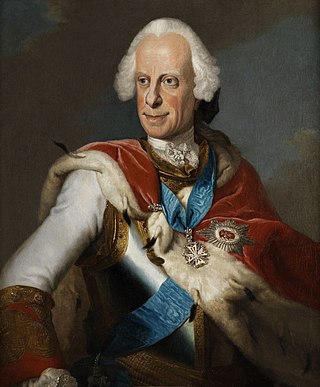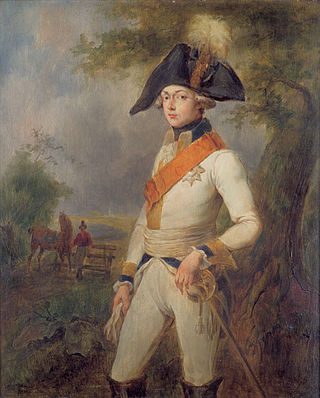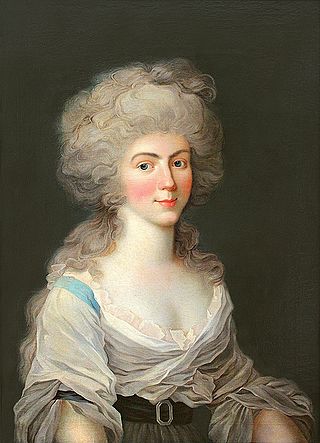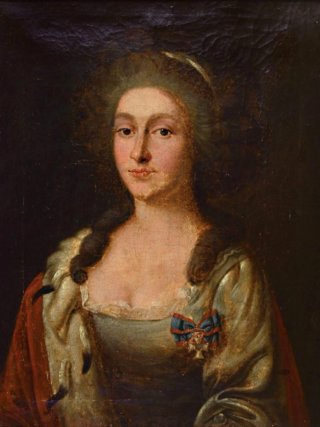
Louis IV was the Grand Duke of Hesse and by Rhine from 13 June 1877 until his death in 1892. Through his marriage to Queen Victoria's second daughter Alice, he was connected to the British royal family. Two of his daughters married into the House of Romanov.

Louis II was Grand Duke of Hesse and by Rhine from 6 April 1830 until 16 June 1848. He was the son of Louis I, Grand Duke of Hesse, and Princess Louise of Hesse-Darmstadt.

Louis I, Grand Duke of Hesse was Landgrave of Hesse-Darmstadt and later the first Grand Duke of Hesse and by Rhine.

Louis IX of Hesse-Darmstadt was Landgrave of Hesse-Darmstadt from 1768 to 1790.

William I, Elector of Hesse was the eldest surviving son of Frederick II, Landgrave of Hesse-Kassel and Princess Mary of Great Britain, the daughter of George II.

Charles II was ruler of the state of Mecklenburg-Strelitz from 1794 until his death. Originally ruling as duke, he was raised to the rank of grand duke in 1815. Prior to succeeding to the throne, he served as Governor of Hanover from 1776 to 1786.

Princess Wilhelmine of Baden, was by birth a Princess of Baden from the House of Zähringen and by marriage Grand Duchess consort of Hesse and by Rhine. Her descendants include King Charles III of the United Kingdom, King Felipe VI of Spain, and other members of European royalty.

Louis VIII was the Landgrave of Hesse-Darmstadt from 1739 to 1768. He was the son of Ernest Louis, Landgrave of Hesse-Darmstadt and Margravine Dorothea Charlotte of Brandenburg-Ansbach.

Ernest Louis of Hesse-Darmstadt was Landgrave of Hesse-Darmstadt from 1678 to 1739. His parents were Landgrave Louis VI of Hesse-Darmstadt and Elisabeth Dorothea of Saxe-Gotha-Altenburg (1640–1709).

Louis VI of Hesse-Darmstadt was Landgrave of Hesse-Darmstadt from 1661 to 1678.

George II of Hesse-Darmstadt, German: Georg II von Hessen-Darmstadt was the Landgrave of Hesse-Darmstadt from 1626 to 1661. He was the son of Ludwig V and Magdalene of Brandenburg.

Prince Frederick Louis Charles of Prussia was the second son and third child of Frederick William II of Prussia and Frederika Louisa of Hesse-Darmstadt.

Princess Augusta Wilhelmina of Hesse-Darmstadt was Duchess consort of Zweibrücken by marriage to Maximilian, Duke of Zweibrücken and the mother of King Ludwig I of Bavaria.

Caroline of the Palatinate-Zweibrücken was Landgravine of Hesse-Darmstadt by marriage to Louis IX, Landgrave of Hesse-Darmstadt. She was famed as one of the most learned women of her time and known as The Great Landgräfin.

Princess Friederike Caroline Luise of Hesse-Darmstadt was a member of the House of Hesse and by marriage a Duchess of Mecklenburg-Strelitz.

Princess and Landgravine Louise of Hesse-Darmstadt was a German princess. She was the daughter of Louis IX, Landgrave of Hesse-Darmstadt. On 3 October 1775 she married duke Charles Augustus of Saxe-Weimar-Eisenach and as such a member of the court sphere of Weimar Classicism. She was held to be serious and introverted but also compassionate and sympathetic, in the aftermath of the Battle of Jena which guaranteed her part in the later "myth of Weimar" ("Weimarmythos").
Alexander, Prince of Erbach-Schönberg was the 2nd Prince of Erbach-Schönberg, eldest son of Gustav, 1st Prince of Erbach-Schönberg.

Frederick V Louis William Christian, Landgrave of Hesse-Homburg was from 1751 to his death landgrave of Hesse-Homburg.

Countess Maria Louise Albertine of Leiningen-Dagsburg-Falkenburg ; also known as Princess George, was heiress to the barony of Broich and by marriage Princess of Hesse-Darmstadt. She was the grandmother and educator of Princess Louise of Mecklenburg-Strelitz, who later became Queen consort of Prussia.
Margaret, Princess of Hesse and by Rhine was the wife of Louis, Prince of Hesse and by Rhine, the last prince of the House of Hesse-Darmstadt. Born in Ireland, she became a noted art patron in her adopted homeland of Germany.


















